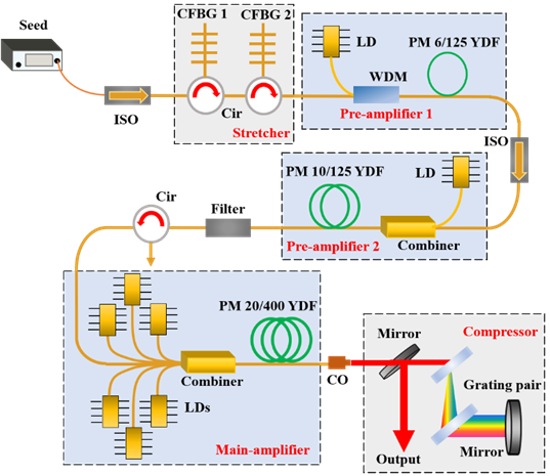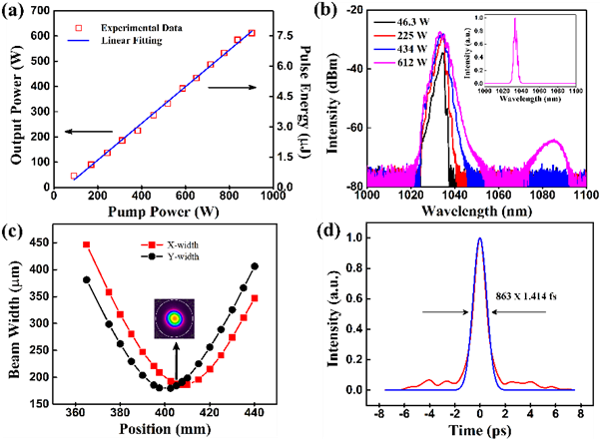Fiber laser has the advantages of a flexible and compact system, high conversion efficiency, good beam quality, and so on, which has attracted much attention. High-power ultrafast fiber lasers have been widely applied in industrial fields and frontier science, such as advanced manufacturing, optical sensing, photoelectric countermeasure, ultrafast physics, and so on.
In previous studies, in order to scale the average power of ultrafast fiber laser, researchers have developed different kinds of fibers with special structures, such as photonic crystal fiber (PCF), chirally-coupled-core fibers, etc., by increasing the core diameter of the fiber to suppress the nonlinear effects and increase the output power. The representative achievement is that an ultrafast fiber laser with average power of 830 W has been realized by leveraging the large mode area (LMA) PCF. However, those LMA fibers with special structures are often difficult to be fusion spliced. In order to couple signal and pump light into the fiber, external bulky optical components for signal collimation and coupling are generally introduced, resulting in the increasement of the complexity of the system, reduction of the robustness, and sacrificing of the advantages of flexibility and compactness of the laser system.
The ultrafast lasers with all-fiber structure have excellent stability by connecting the optical components through fiber fusion splicing. However, the output power of all-fiber ultrafast lasers is lagging behind that of its free-space coupled counterparts. Essentially, the smaller mode area and longer transmission distance of conventional fiber lead to stronger nonlinear effects, which restricts the power scaling of ultrafast lasers. In view of this, the researchers from the National University of Defense Technology broadened the ultrafast laser from ps level to above ns level in the time domain by cascading chirped fiber Bragg gratings (CFBG), to reduce the peak power of the pulse and thus the nonlinear effect in the amplification process. The commercial LMA fiber with core/cladding diameter of 20/400 μm was used to construct the CPA system with an all-fiber structure. The ultrafast laser with an average power of 440.6 W and pulse width of 863 fs after compression was realized. This work was published in High Power Laser Science and Engineering, vol. 11, Issue 2 (Tao Wang, Can Li, Bo Ren, Kun Guo, Jian Wu, Jinyong Leng, Pu Zhou. High-power femtosecond laser generation from an all-fiber linearly polarized chirped pulse amplifier[J]. High Power Laser Science and Engineering, 2023, 11(2): 02000e25).
The structure configuration of this high-power all-fiber CPA system is shown in Fig. 1, which includes an ultrafast laser oscillator, a stretcher, pre-amplifiers, a main amplifier, and a compressor. The seed signal has a repetition rate of 80 MHz with a pulse width of 6 ps. In order to reduce the peak power of the pulse and the nonlinear phase shift during amplification, two cascaded CFBGs were used as the stretcher to broaden the pulse to the full width of 2 ns. Then, the stretched pulse was successively passed through two pre-amplifiers to boost power and then launched into the main amplifier. The main amplifier employed a highly-doped Ytterbium-doped fiber (YDF) with a core/cladding diameter of 20/400 μm. Due to the large pulse broadening ratio in the time domain, it is not necessary to use the fiber with core diameter of 30 μm or above to suppress the nonlinear effects. The well-developed commercial fiber with core/cladding diameter of 20/400 μm, which is beneficial to suppress the transverse mode instability effect (TMI) at high average power, was employed to construct the all-fiber system, leading to the balance between the beam quality and the nonlinear effect. The amplified laser signal was collimated and then compressed by a pair of diffraction grating.

Fig. 1. Experimental setup of the high-power all-fiber CPA system.

Fig. 2. Experimental results of the high-power all-fiber CPA system: (a) output power and single pulse energy; (b) output spectra at different power levels, inset: linear spectrum at the highest power; (c) beam quality and (d) compressed pulse width at the highest power.
Based on the above experimental setup, the highest average power of 612 W was achieved before pulse compression, as shown in Fig. 2 (a). Figure 2 (b) shows the output spectra at different powers. Obvious stimulated Raman scattering (SRS) effect can be observed at the highest power, and further power enhancement was also limited by SRS. At the highest power, the M2 factor was measured to be 1.29 (Fig. 2c), indicating a near-diffraction-limited beam quality. Moreover, the pulse was compressed to 863 fs (Fig. 2d), corresponding to the highest compressed power of 440.6 W.
The above results indicate that it is a feasible technique to increase the average power of ultrafast laser by cascading CFBGs to realize a large pulse broadening ratio in the time domain. In the future, pulse-shaping technology will be exploited to alleviate the nonlinear effects and gain-narrowing effect during the amplification process, so as to realize high power ultrafast laser with narrower pulse width. In addition, the ultrafast fiber amplifier developed in this experiment will be applied in an ultrafast laser coherent beam combining system to further break through the power limits of a single fiber.


